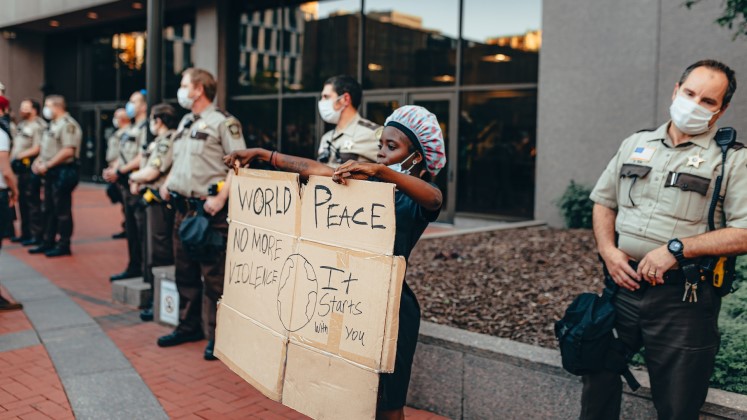 Last year saw a Supreme Court decision which meant the legalization of same-sex marriage across the entire of the United States. Canada too, though having a very different political system, has legalized same-sex marriage at the national level via its Supreme Court. Australia, by contrast, has not yet legalized same-sex marriage, despite having a largely similar political system to Canada’s. Mary Bernstein writes that the differences cannot be explained by public opinion alone; unlike Canada and the US, Australia does not have a federal bill of rights, nor are its courts an avenue for people to gain rights that are not set out in law.
Last year saw a Supreme Court decision which meant the legalization of same-sex marriage across the entire of the United States. Canada too, though having a very different political system, has legalized same-sex marriage at the national level via its Supreme Court. Australia, by contrast, has not yet legalized same-sex marriage, despite having a largely similar political system to Canada’s. Mary Bernstein writes that the differences cannot be explained by public opinion alone; unlike Canada and the US, Australia does not have a federal bill of rights, nor are its courts an avenue for people to gain rights that are not set out in law.
Shifts in public opinion cannot adequately explain changes in public policy. If we look across the country at contentious issues such as abortion rights or same-sex marriage, it would be too easy to claim that public opinion is the primary driver behind public policy shifts. Instead, differences in political and legal structures explain why some countries have changed their policies regarding recognizing same-sex relationships more quickly than others.
Take the case of same-sex marriage. The highest court in Canada found in favor of same-sex marriage in Canada in 2003 and same-sex marriage became legal in the US in 2015, twelve years after the Supreme Judicial Court of Massachusetts made Massachusetts the first of many US states to recognize same-sex marriage. Australia, on the other hand, has yet to legalize same-sex marriage.
On the face of it, Australia and Canada are more similar politically than either country is to the US. In both countries, the federal government, not the states or territories regulate marriage, in contrast to the US, where the states are empowered to regulate marriage. Both Australia and Canada have stronger social safety nets, provide significant legal protection and social validation to non-marital relationships (called common-law relationships in Canada and de facto relationships in Australia), and are part of the British Commonwealth. So why is Australia so far behind Canada and the US?
Public opinion alone cannot explain these differences. Australians overwhelmingly support same-sex marriage according to recent polls. Organized opposition cannot explain the different timing in policy change, since the Religious Right in the US that opposes same-sex marriage has been significantly stronger and better funded than its Australian counterpart.
Instead, the structure of the courts and the existence of a bill of rights is critically important in explaining the differences in the timing of enacting same-sex marriage. In Canada, legal change in any province can be appealed to the Canadian Supreme Court, making legal change more far-reaching. In the US, legal change is much slower, as each state has its own constitution and a change in Massachusetts only affects Massachusetts. However, if the US Supreme Court agrees to take a case, then the effect can be national, as in the case of Obergefell v. Hodges, the case that made same-sex marriage legal in those US states that still hadn’t recognized same-sex marriage.

Canadian lesbian and gay activists are also helped because Canada’s Charter of Rights and Freedoms has been interpreted to include sexual orientation as an analogous ground of protection, on a par with race, and so the threshold for achieving rights is much lower in Canada than in the United States. But the existence of a Bill of Rights has also given lesbian and gay activists legal ammunition with which to argue for change.
Australia, on the other hand, does not have a federal bill of rights and the courts are not an avenue for seeking rights not already enumerated through existing law. As a result, international law became much more important in explaining the recognition of same-sex relationships in Australia than in Canada or the US
So while Australian activists have not been able to use domestic law to gain same-sex marriage, activists have made considerable use of international law. Australia’s Human Rights and Equal Opportunity Commission (HREOC), now known as the Human Rights Commission, is an independent agency funded by the government whose task is to make sure that Australia legislates in accordance with its international human rights commitments.
In 2006, HREOC began an inquiry into the inequalities faced by gay men and lesbians in Australia, resulting in a 2007 report titled Same Sex, Same Entitlements that detailed the federal laws that discriminated against same sex couples and their children. This report, based on thousands of submissions from across the country, galvanized activists to seek de facto recognition for their relationships. Despite the HREOC report, the government of then-Prime Minister John Howard refused to accept the recommendations. Once the opposition Labor Party took power, they quickly enacted legal recognition of de facto relationships on a par with those of heterosexual de facto couples. De facto recognition gave same-sex couples most of the same rights as legally married heterosexual couples, but still did not provide the much coveted access to marriage.
So while international law provided a political opening for lesbian and gay activists to gain de facto recognition, there was no basis in international law by which to recommend same-sex marriage and so the impact of international law (at least as of this writing) stopped short of marriage.
While Canada, the US and Australia share many important political and cultural similarities, the structure of the political system, more than public opinion, is what explains differences in the timing and types of legal recognition of same-sex relationships.
This article is based on the paper ‘Altared States: Legal Structuring and Relationship Recognition in the United States, Canada, and Australia’, in American Sociological Review.
Please read our comments policy before commenting.
Note: This article gives the views of the author, and not the position of USAPP – American Politics and Policy, nor the London School of Economics.
Shortened URL for this post: http://bit.ly/1Qa6NhA
_________________________________
 Mary Bernstein – University of Connecticut
Mary Bernstein – University of Connecticut
Mary Bernstein is Professor of Sociology at the University of Connecticut. She has published numerous articles in the fields of social movements, identity, sexualities, gender, and law and is co-editor of three books.






